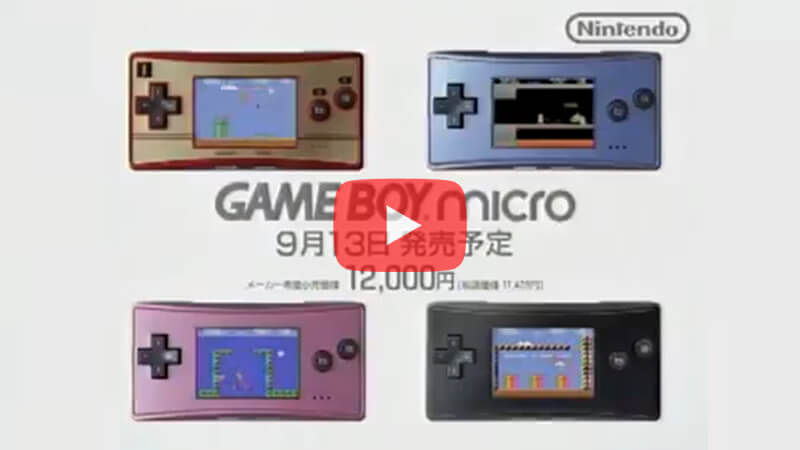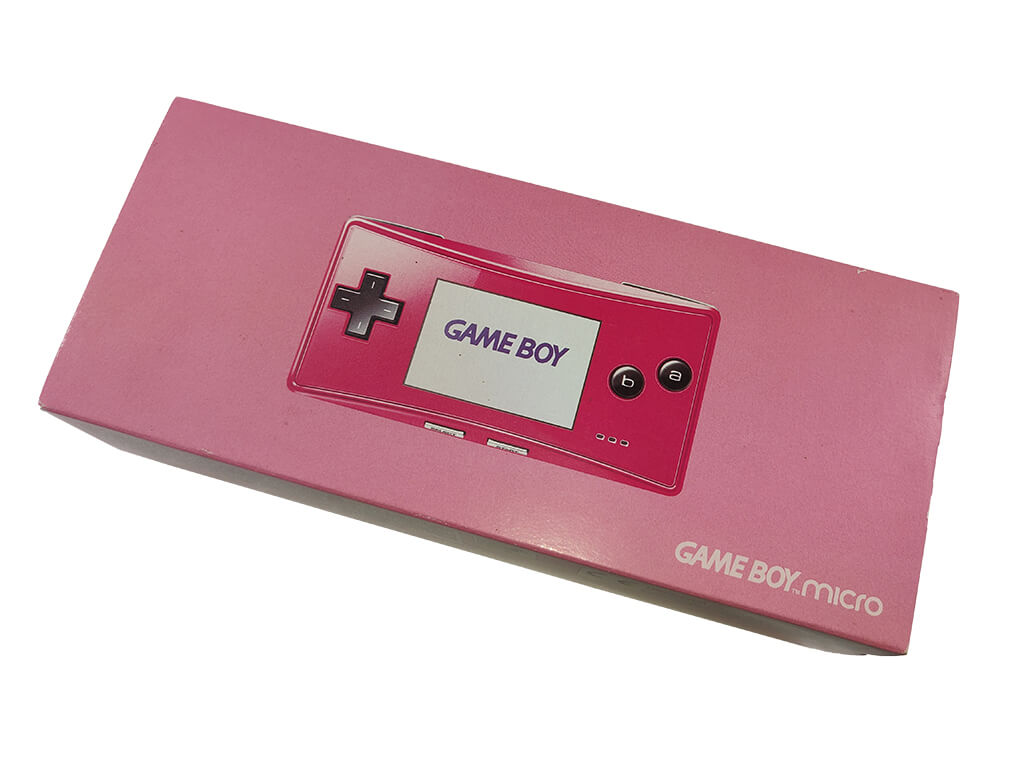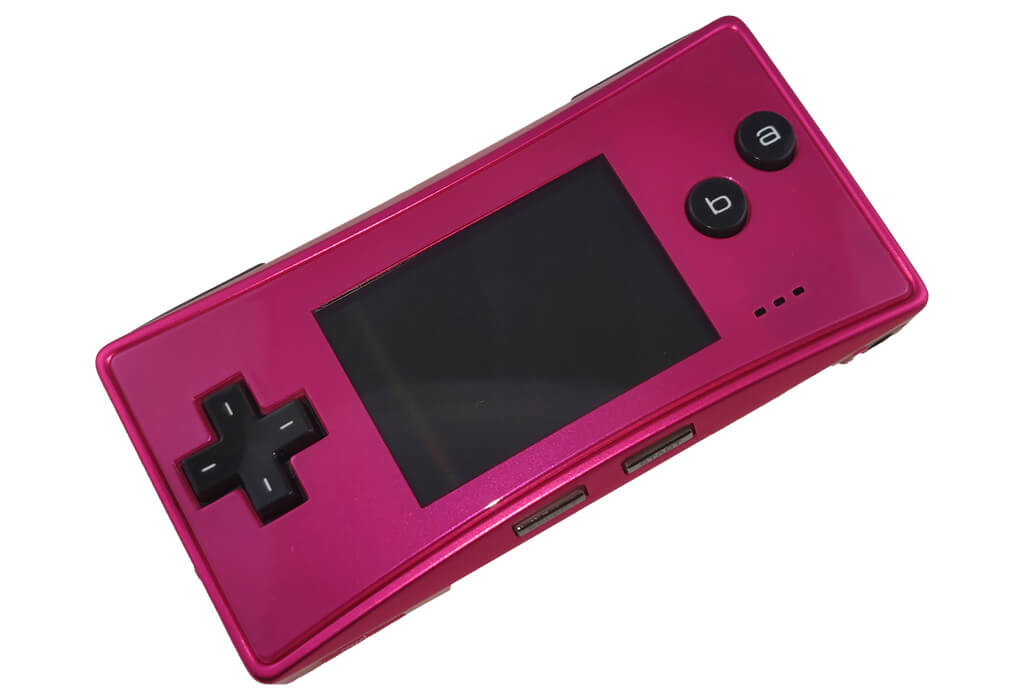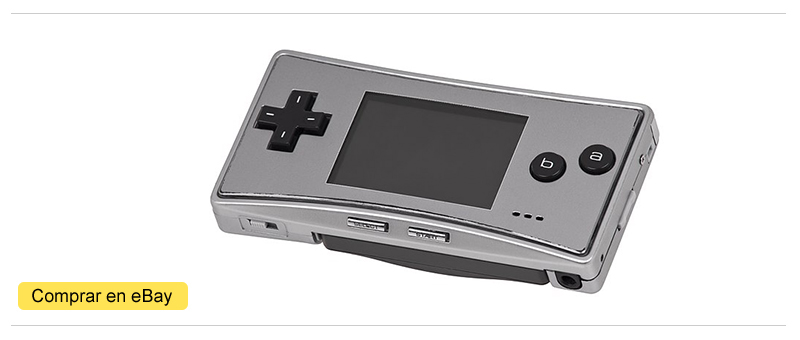The Game Boy Micro was presented at E3 on May 18, 2005, being released a few months later on September 13, 2005 in Japan, coinciding with the 20th anniversary of Super Mario Bros. Codenamed OXY (from “oxygen “), the laptop was quite a surprise for the video game industry.
With a design with a strong Japanese minimalist influence, the Game Boy Micro reduced the dimensions of the Game Boy Advance to the minimum expression, integrating a backlit screen with a quality that we had never enjoyed before. Let’s remember how it was what for many is the best portable console in history, the Game Boy Micro.
| COMPANY: | Nintendo |
| CONSOLE GENERATION: | 6TH GENERATION OF CONSOLES |
| RELEASE DATE:: | September 13, 2005 in Japan September 19, 2005 in North America November 4, 2005 in Europe |
| GAMES CATALOG: | 1,538 GBA video games (including budget and classic versions) |
| SOLD UNITS: | 2.42 million units worldwide |
| LAUNCH PRICE: | 12,000 yen |
| PROCESSOR: | 32-bit CPU (16.78MHz). |
| FORMAT: | Cartridge |
| BUY IT ON EBAY: | https://ebay.us/HEn4bQ |
- History of the Game Boy Micro
- The Game Boy Micro, the best Nintendo portable?
- Price of a Game Boy Micro console, how much did it cost?
- Collecting the Game Boy Micro
- Buying a new or used Game Boy Micro
- TOP Retro: Best Game Boy Micro Games
- FAQ Game Boy Micro
- Technical characteristics of the Game Boy Micro
- Original article from 2005
Game Boy Micro
The Game Boy Micro was, in the first place, a complete surprise for the “gamer” community. When all of us players were experiencing a new and frenetic “Console War”, witnessing a battle of giants in the field of portable consoles between Nintendo with its Nintendo DS and Sony with its PSP, Nintendo almost by surprise launched a new model for Game Boy Advance 32-bit worldwide.
The new console was called Game Boy Micro in honor of its dimensions (101 mm wide x 50 mm high x 17.2 mm thick), this being the most notable aspect at first. Let us remember that in those years the most advanced mobiles were the Nokia 3250 XpressMusic, Sony Ericsson W800 or the HP iPAQ HW6515 among others, consequently, having in our hands a 32-bit console of these dimensions was undoubtedly a sign of technological evolution and hard to believe miniaturization, as we can see in one of its launch announcements:

In the ad you can see the actor Satoshi Tsumabuki in the dressing room, who after leaving him a GameBoy Micro by surprise, innocently asks “What is this? Can you make an Advance like this?”. It’s an advertisement, but it was exactly the same feeling we all had when trying Nintendo’s console for the first time, since the GB Micro was much more than a reduced GBA:
Weighing only 80 grams, its minimalist design featured an aluminum casing and removable and interchangeable faceplate. As happened with the GBA SP, the GBM incorporated a lithium battery that offered us between 6 and 10 hours of pure vice in what was possibly the best backlit screen that a console has ever had in terms of quality/time. still having a size of 2 inches.
But of course, all this had both an economic and a hardware cost, and that is where we find the negative points of the console:
- The Game Boy Micro completely lost compatibility with Game Boy Classic and Game Boy Color games. A loss difficult to justify, when we were finally going to have the opportunity to enjoy the entire Game Boy catalog on a luxurious backlit screen.
- 12,000 yen. Nice, minimalist, small, high-quality screen… But 12,000 yen, an excessive price for a system from 2001 that most potential buyers already owned in its previous versions, and that was already being replaced by the Nintendo DS.
The result was that, even at launch, sales fell short of the Game Boy Advance SP itself, which was sold considerably cheaper and was compatible with Game Boy cartridges from the 1980s and 1990s. The Game Boy Micro was attempted to be marketed as an exclusive product for a very specific high-end audience, but the strategy did not work, especially if we think that at its launch the NDS and the really exclusive portable (by price), Sony PSP, already existed. aimed at an adult audience.
Hey! If you're enjoying the history of the Game Boy Micro, we highly recommend reading the main system article: The Original Game Boy Advance. There you will find all its history, background, modding and the very development of the system according to its own creators. A real jerk!
Within Nintendo, no one in Europe and the United States understood the Nintendo Japan movement, which could have been an eccentricity exclusive to Japanese lands as the 64DD or Twin Famicom were in their day, was exported and released almost at the same time throughout the world. world. The console that would go down in history as the farewell to the mythical Game Boy brand, became a real nightmare for foreign delegations, which were focused on the launch of the Nintendo DS and already liquidating the stock of GBA and GBA SP , suddenly they had to justify the launch and corresponding purchase of a new GBA console in 2D, before new generation beasts like the NDS and PSP.
The Game Boy Micro was an absolute commercial failure if we value it with the usual Nintendo figures: 2.4 million units sold worldwide, it was the farewell to the Game Boy brand that had given us so much joy. We could justify that a 2D console with 16-bit aesthetic games could do little in the face of, for example, the graphic bestiality offered by the Sony PSP and its games, but the GBM really failed on its own:
Excessive price, incompatibility with the GB and GBC and the most controversial, which in theory was its best asset, that is, its screen, was also its main problem: Its small size made it impossible to enjoy long game sessions or play acceptably, in those video games in which we had to read a lot of text... Quite a shot in the foot in one of the systems that most JRPG have enjoyed.
The Game Boy Micro, the best portable Nintendo console?

Ok, it is true that the Game Boy Micro failed commercially at the time, but almost two decades later our perception and way of evaluating things have changed a lot, so it is pertinent to ask ourselves the following question: is the GBM the best nintendo handheld?
Before answering this question, we must know a fundamental aspect when it comes to developing consoles by Nintendo, much more so when it comes to portable consoles:
The perfect balance in Nintendo portables.
For Nintendo engineers, creating a system like the GBA in the beginning was a huge challenge for one main reason: Finding the perfect balance between Price, Performance, Dimensions, Batteries and Production/logistics. This development philosophy had brought great success and revenue to Nintendo throughout its history, the original Game Boy being a perfect example, a cheap console, with a 4-color screen, that fits in a pocket, lasts 24 hours of play and it was easy to produce.
Maintaining the balance between these 5 aspects is a fundamental factor that makes the difference between the success and failure of a system, and it must be taken into account that depending on the audience each console is aimed at, we will have to prioritize one parameter or another since the end user of a PS Vita is the same as a 2DS, for example.
Still existing in 2001 (launch of the GBA), the technology to launch a console with smaller dimensions and higher performance, using miniaturized hardware parts on a smaller scale (nanometers) already used in mobile telephony, this would have meant raising the price end of the GBA and most importantly, not being able to count on the production rate necessary for the system’s demand (logistics), a demand that is counted in the millions on a Nintendo console like the original Game Boy Advance.
Using more common hardware parts that are readily available and are manufactured by the millions of units per month in different factories, makes it possible to have launches of millions of units of consoles at the height of the demand (something that other companies have not learned) and maintain over time the supply chain, regardless of the problems that may arise in a particular factory or country.
On the other hand, using the latest technology processors and other hardware will cause the assembly line to be weighed down by the lower production rate of the most complex technologies, it being common for certain latest generation components to be manufactured in a single factory, with productions that, for example, can be 200,000 chips per month, an insufficient print run for a successful product like the Game Boy Advance.
Consequently, the engineers of the original GBA were forced by logistics and balance philosophy to use common components that were easy to manufacture, in addition to the price, to ensure that the production of the console would never be in danger.
Having explained this key operation in the Nintendo of the 80’s, 90’s and early 2000s, we can affirm that the Game Boy Micro is the console that engineers and developers always wanted to create and never could due to the principles of “perfect balance”. … Until the year 2005, when the technology had advanced enough to incorporate a fancy backlit screen, in a minimalist console at an acceptable price for an adult audience and with correct energy consumption. The perfect new balance for a new target audience.
Seen from this perspective, the question makes sense since we are talking about the perfect Game Boy Advance for engineers and developers, but there is more: Anyone who has been to Japan will have been surprised by the frenetic pace of its inhabitants in big cities, steps accelerated, staring ahead, racing to get to the subway or train, eating in 5 minutes… Until they reach public transport. They are for the world.
They go from an accelerated pace to being still, stopped and with 30, 40 or 50 minutes until their destination… What do they do? The older ones sleep stoically without losing their composure and the younger or middle-aged ones, lower their heads and get hooked on reading manga or on the mobile phone all the way to the fashionable game… And that’s exactly where the Game Boy Micro is perfect again. A really pocket-sized console, with the immediacy of cartridges and a luxury catalog in a few years when the iPhone didn’t even exist (2007).
For the wealthy Japanese public, a country in which 50-year-old office workers spend their afternoons in arcades, thanks to the fact that video games are considered a hobby for all ages, fully assimilated since the 70s (since it is their industry) , the Game Boy Micro made all the sense in the world, much more if we think that 14 million people live in Tokyo alone, to which must be added all the daily commutes from neighboring towns and cities (adding more than 25 million passers-by ).
Nintendo bet heavily with its minimalist concept focused on being able to play a game quickly anywhere, compared to other more powerful consoles of larger dimensions such as the Nintendo DS… And it went wrong. Even so, despite not having been commercially successful for the reasons already stated, many years later we can say that the Game Boy Micro was indeed the best console for a very specific audience, which coincidentally coincides to a great extent with the style of life that many of us lead today: Adults, with work and families who love retro things… I’ll leave it there.
The price of the original Game Boy Micro
How much did a new Game Boy Micro cost? Nintendo released the GB Micro for a suggested retail price of 12,000 yen. Next, we can compare what those 12,000 yen meant with the rest of the contemporary consoles:
| CONSOLE | LAUNCH | LAUNCH PRICE | BRAND |
| Game Boy Color | 1998 | 8.900 yenes | Nintendo |
| Neo Geo Pocket | 1998 | 7.800 yenes | SNK |
| WonderSwan | 1999 | 4.800 yenes | Bandai |
| Neo Geo Pocket Color | 1999 | 8.900 yenes | SNK |
| New Neo Geo Pocket Color | 1999 | 6.800 yenes | SNK |
| WonderSwan Color | 2000 | 6.800 yenes | Bandai |
| Game Boy Advance | 2001 | 9.800 yenes | Nintendo |
| SwanCrystal | 2002 | 7.800 yenes | Bandai |
| Game Boy Advance SP | 2003 | 9.800 yenes | Nintendo |
| Nintendo DS | 2004 | 15.000 yenes | Nintendo |
| Sony PSP | 2004 | 19.800 yenes | Sony |
| Game Boy Micro | 2005 | 12.000 yenes | Nintendo |
The first thing that strikes us about its price in relation to the competition is the 3,000 yen difference with the Nintendo DS: 15,000 yen for the NDS VS 12,000 yen for the GBM… Surreal.
Despite being a unique console, the price of the GB Micro was outrageously high if we compare it with the new Nintendo console, the NDS, which had a double backlit screen and polygonal graphics at the level of the Nintendo 64. All nonsense that contributed to the fact that the sales of the GB Micro were derisory to be a Big N console.
Collecting the Nintendo Game Boy Micro
Is the Game Boy Micro worth collecting? Of course, although I always respond the same to any system from the 3rd generation of consoles… But if you like retro video games, collecting the Game Boy Micro makes all the sense in the world. It is a beautiful and almost perfect console, as easy as that.
Unlike many other systems, the GBM is indeed a pocket console, to always be with us. What do you already have the mobile? Please! The GB Micro’s controls make touchscreens cry at night as they pray their companies include a D-pad and 4 buttons in the next model. There is no color.
Coincidentally, as we have already mentioned, over the years our rhythm of life is very similar to that of those Japanese office workers of 2005: Family, work, studies and hopefully some social life, mean that our free time is reduced to a minimum. , so when we have 15 free minutes we have the urgent need to ENJOY THEM… And that’s where the Game Boy Micro appears again, the perfect console to fill those gaps and leave us with the feeling of having USE those few minutes of time . If you haven’t reached 40 you’ll understand me in a few years…
Fortunately for everyone, the Game Boy Micro has been distributed all over the world, so it is relatively easy to find a console in good condition, the price? That’s another thing…
Buying a new or used Game Boy Micro console
The demand for the Game Boy Micro is very high, the console that at the time was dismissed by the vast majority of players, many years later it has become the object of desire of all nostalgic nintenders and retro collectors. Since there are just over 2 million consoles, this high demand has put the price through the roof, much more if it is with a box.
To give a clarifying example, most people who search for the words “Game Boy Micro” do so with the intention of buying a new or second-hand console, so we can forget about finding any bargain. None.
To check it out here below you have a link to eBay where you will find a list with the updated prices of the new Game Boy Micro with box and second-hand, prices fluctuating largely according to their condition. The link is an affiliate link, so if you buy something at Infoconsolas we will take a small commission that we use to buy and preserve retro consoles. Let’s see the prices and talk…
At the time of writing this post, the prices of the second-hand Game Boy Micro are from 150 euros without the box to 500 euros complete, in both cases in very good condition… A madness that unfortunately has no prospect of lowering the price .
As we usually recommend in Infoconsolas, if you are interested in buying a Game Boy Advance, be patient, know the market prices and set a fair and real figure in relation to the use that you are going to give to the console and its condition. If you buy on eBay, auctions stopped being cheap many years ago, so the best option is to hunt for a “Buy It Now” that is well priced right out of the box. Good luck everyone and enjoy the hunt, not just the prize!
STOP COLLECTOR! If you’ve seen the console listing on eBay, I want to say THANK YOU. Since 2004, the objective of Infoconsolas is to contribute to preserving the history of consoles and video games through our own collection of systems and the hours of work invested in this very website.
Being an eBay partner listing, if you buy a game or console, you will be helping Infoconsolas in the preservation of video game culture, so thank you very much again!
TOP: Best Game Boy Micro Portable Games
In the same way that we have done with the rest of the GBA system models, from Infoconsolas we offer our most humble tribute to Mr. JARM, sharing with you one of his GBA videos: The 20 best GAME BOY ADVANCE games of all time (THE DEFINITIVE TOP).

FAQ Game Boy Advance Micro
Below we show the main questions and answers that the girl makes regarding the Game Boy Micro:
No.
Yes.
Part of its casing is.
Yes, it is interchangeable for multiple designs.
There are a total of 1,538 video games for the system.
Cartridges.
Your CPU is 32 bit.
It had a recommended price of 12,000 yen at its release in Japan.
Yes, its quality is amazing.
Yes, but the hardware of the console is focused on 2D due to resource and energy consumption.
September 13, 2005 in Japan, September 19, 2005 in North America, and November 4, 2005 in Europe.
80 grams.
Yes, plenty. It is Nintendo’s most “portable” console.
Samurai Deeper Kyo, released on February 12, 2008.
Not as a “Game Boy” brand console, it was the last Game Boy, a real tribute.
In terms of screen and battery quality, the GBA Micro. Precious.
Technical characteristics of the Game Boy Micro portable video game console
Here are the Game Boy Micro’s own specs, based on original Nintendo data:
- Measurements: 101mm wide x 50mm high x 17.2mm thick.
- Weight: 80 grams.
- Format: GBA cartridges.
- Display: Backlit TFT color LCD adjustable in 5 modes.
- Screen size: 2 inches (28.32mm x 42.48mm).
- Frames per second: 60 Hz.
- Resolution:
– GBA: 240 x 160 pixels (3:2 aspect ratio). - Color: 32,000 colors.
- CPU:
– 16.8 MHz 32-bit RISC with onboard memory for GBA games.
– 8-bit CISC CPU (Japanese version only). - Memory:
– VRAM: 32KB (integrated in the CPU).
– DRAM: 288k bytes (integrated in the CPU). - Power supply: lithium battery.
- Lithium battery life:
– 6 to 10 hours of use. - Power Consumption: Approximately 1.6 W (at load)
- Battery charging time: 2.5 hours.
- Entrance exit:
– 8-way crosshead.
– Buttons A, B, L, R, Start, Select.
– Volume control.
– Button On/Off.
– Cable link/charger input, headphones.
External sources and links
- Console external graphics resources:
https://commons.wikimedia.org/wiki/User:Evan-Amos
Original analysis of the Game Boy Micro in 2005
Yes, Infonconsolas is a veteran console and video game website… Born in 2005, little by little we are updating the console articles with the aim of offering better content about all the consoles in history, but sometimes we come across original analyzes that provide an important point of view of the time that is interesting to preserve.
The following article is the original review of the Game Boy Micro before it was released, apologies for the redaction in advance, it’s interesting to see what we expected from the console and what happened in the end… Quite a throwback to the past needless to say! of a DeLorean!
Sorry, we can not be impartial to the Game Boy Micro, this portable video game console is, quite possibly, the most beautiful console that has been made to date, a minimal and simple design, made with the best materials and the best screen that many of us remember, makes one of Nintendo’s smallest consoles truly the greatest machine in terms of quality/performance/fun.
The Game Boy Micro is not for everyone, only for purists, only for collectors, only for those of us who know how to appreciate the quality of a good 16-bit aesthetic game, in a 32-bit machine that fits us to spare, in the small pocket of our worn jeans. In the following article you will witness how we received it in the middle of 2005… So many years ago!
LAUNCH DATE: 2005 Japan, 2005 North America and 2005 Europe.
The Game Boy Micro has already been presented to the world, Nintendo chose E3 2005 to surprise us all with a new version of GBA.
Nintendo has managed to compress the Game Boy Advance SP even more, to make way for a new GBA, the Game Boy Micro, as usual the first thing that draws attention are its measurements:
50 mm high x 101 mm long x 17.2 mm thick… the weight: 80 gr

As you can see the dimensions are really amazing, it is the minimum size to get a good gaming experience both in gameplay (controls), and visual (screen). According to Nintendo, the GB Micro has the best screen that a Game Boy or GBA has ever had, they promise us a sharpness never seen before and they add a brightness regulator.
The GBM will be compatible with its older sisters, both in games and in most accessories, we say the majority because this console has a very important “scene”, so it has accessories that Nintendo does not like very much, such as the blank cartridges with USB for example.

Was another GB missing?
This is the first question we asked ourselves at Infoconsolas when we heard the news, the truth is that it was a complete surprise that caught us off guard.
When the last generation consoles are going to come out, and the new portable consoles such as the Sony PSP or the Nintendo DS are already on the market, which far exceed the possibilities of the GBA, Nintendo goes and announces a new GB.
With such circumstances, it’s easy to think that the GBM’s days are numbered even before going on sale, but we think that Nintendo, with a good strategy, can make its small GBM go very far…

This is how we see it in Infoconsoles
For us, the GB Micro market has 2 very well defined audiences:
- A very young audience, as happened with the first GB, this laptop may be destined to be the first console for many boys and girls.
- A more casual adult audience, due to its size, design and its large catalog of games, the GB Micro is a perfect console to play a game anywhere, and even always carry it with you (hospital visits, dentist, girlfriend combing hair that in “5 minutes” goes down…). We must remember that the GBA has retro games from the NES, classics that have a great pull for an audience of a certain age.
For the GB Micro to succeed there is only one condition, that it be CHEAP. The GBA Micro has to be really cheap, Nintendo knows that the GBA was a product that was destined to die with the arrival of the new portables. With the GB Micro Nintendo gives a new injection of life to its GBA giving the possibility for the little ones to have their first console (few parents are going to buy a Sony PSP for a 6-year-old child) and for those who are no longer so small, but they are not willing to pay more than 150 Euros to play a game from time to time.
With the Game Boy Micro, it offers us a “new” console concept, an affordable and truly portable console, Nintendo will ensure that the GB catalog continues to increase for the benefit of all, and they will preserve a source of income that seemed destined to disappear with the NDS and PSP.
As we have mentioned before, at Infoconsolas.com we think that all this will be fulfilled if Nintendo meets a single and logical requirement, the GB Micro must be really cheap.


